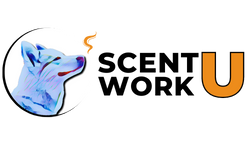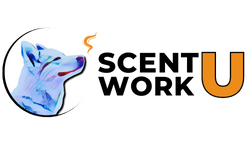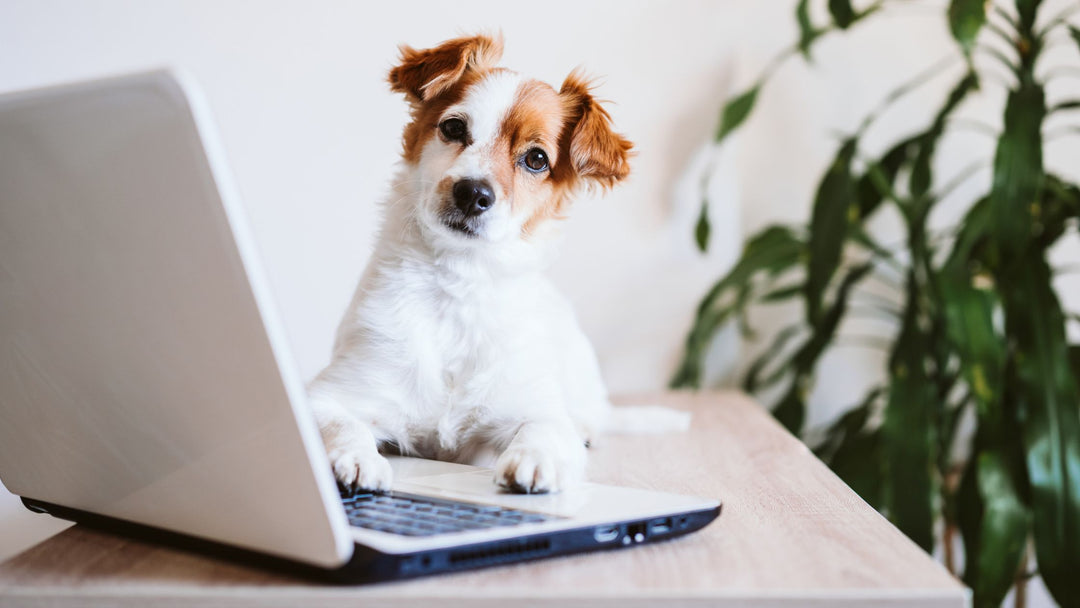Trials and Tribulations of Being a Dog Handler

We oftentimes overlook how challenging it is to be a handler in any dog sport, Scent Work included. Essentially, handlers must learn all there is to know about the sport, internalize it, utterly understand all those concepts, and then teach those very same concepts and skills to their dog – an alien species – while identifying whether their dog is doing well or struggling and take that information to adjust along the way.
Basically, dog handlers must learn and teach at the very same time. It is a tall order! Thus, we should be more open to how challenging being a dog handler can truly be while cultivating ways for handlers to rise to meet this challenge.
BREAK IT DOWN
If I were to task you with learning quantum mechanics right now and then immediately turn around and teach it to someone else, who you barely knew, so that they could take the test for you and pass with flying colors, you would look at me as if I were crazy. Yet, that is what dog training is oftentimes like.
An instructor will give directions to a dog handler and they are, in turn, expected to translate that into something actionable for their dog to do, a behavior or action that is being tested. Ideally, this behavior or action will be flawless the very first time, or at least that is the apparent expectation.
On its face this is ridiculous, and I am saying that as an instructor!
“But, if my instructor demonstrates something, I can just copy them. It will be fine!”
Demonstrations indeed have their place and can be effective but will only get you so far. Every dog and handler are individuals and together they make up a unique team. There may exist some type of intricate detail that would only apply to that specific dog, that specific handler or that specific team as a unit that is not addressed in the demonstration. Thus, merely mimicking what an instructor demonstrates may lead said specific team astray.
In my opinion, handlers must understand not only the “how” to do something, but the “when” and most importantly the “why”. Translation: handlers should have a solid understanding of a concept before trying to teach their dog about that very same concept.
As an example, let’s say that I tasked a handler with setting up an exterior search with 2 hides where 1 hide is elevated, and the other hide is inaccessible. Oh, and the search must be done on-leash.
From this simple exercise, what does the handler need to know?
- What would be considered an exterior search and why?
- What is the size of the search area and why?
- What is the composition of the search area and why?
- Where should the boundaries be and why?
- Where should the start line be and why?
- What are the potential weather and environmental factors and how will they play a role (wind, humidity, etc.)?
- What types of hide should the handler use (food, paired odor, or target odor) and why?
- What would be considered an elevated hide and how high should that hide be and why?
- Could an elevated hide also be an inaccessible hide, why or why not?
- What would be considered an inaccessible hide and why?
- What canine body behavior are they looking for to illustrate their dog found the hide and why?
- How does the handler expect their dog will tackle the search and why?
- What signs or signals would the dog be giving to illustrate they are rising to the challenge, struggling, or falling apart?
- Does the handler know how to handle a leash or long line while searching?
- How will the handler use the leash or long line during the search?
“I need to know all of that to run a search with my dog?!”
Ideally.
“BUT WHY?!”
Well, what happens if something goes astray? What happens if your dog doesn’t find a hide or if they quit? What if they are working their tail off but just cannot seem to find the hide no matter what they do? What if they look as though there are no hides or odor in the space at all?! What if every time they start to zero in on the hide, they suddenly pull off and stop? Why are they doing that? Could it be a result of your handling or is it an aversion to odor or is it some strange behavior chain that you have inadvertently baked into the game?!
These are all very real possibilities that you, as your dog's handler, trainer and teammate, need to have answers for.
Handlers must know WHY something is happening during a search so they can address it in subsequent training or practice sessions. This also includes good things! If your dog nailed the inaccessible hide, you want to know WHY they did so well so you can further build off that success going forward, not undercut it by mistake!
FINAL THOUGHTS
My suggestion for any handlers who are working with an instructor or trainer is to ask questions. Lots and lots of questions. The sole duty of your instructor and trainer is to help you and your dog learn the necessary skills to be successful. They are not merely your hide-placer-and-picker-upper, or at least they shouldn’t be. Instead, they are your coach and partner. In my opinion, instructors and trainers should be nurturing you to step into the role of trainer yourself, helping to highlight what specific steps and tricks would work for yourself, your dog, and your team, knowing these very same insights may be detriment to another dog/handler team.
Be kind to yourself. Learning, handling, and training a dog at the very same time is HARD. Give yourself the time and space to understand a concept yourself first. If that means that you will not be able to do it perfectly in class, in that moment with your dog, that-is-fine. Ensure you know the “hows”, “whens” and “whys” for when you practice on your own.
Have an open and honest discussion with your instructor or trainer. Be upfront with them. For instance, you can let them know that you are nervous or are worried about disappointing them.
Be honest with yourself. Are your training sessions stressing you out? If so, when and why? Being stressed out when you are training, beyond the normal stresses of learning, is a sign of trouble. Partner with your instructor or trainer to come up with a solution.
Being a dog handler is hard. It is challenging. It can be trying. But it is also incredibly rewarding, once all the pieces fall into place. If you are realistic and mindful, and resist the urge to rush, you and your dog will do just fine.

Dianna has been training dogs professionally since 2011. She has done everything from teaching group training classes and private lessons, to specializing in working with fearful, reactive and aggressive dogs, to being a trial official and competition organization staff member.
Following a serious neck and back injury, Dianna was forced to retire from in-person dog training. But she was not ready to give up her passion! So, she created Pet Dog U and Scent Work University to provide outstanding online dog training to as many dog handlers, owners and trainers possible…regardless of where they live! Dianna is incredibly grateful to the amazingly talented group of instructors who have joined PDU and SWU and she looks forward to the continued growth of PDU and SWU and increased learning opportunities all of these online dog training platforms can provide.
In June 2021, Dianna and her business partner, Sean McMurray launched Cyber Scent Work, Inc., an organization that operates in the gray space between training and trialing in Scent Work. With Cyber Scent Work, Inc., handlers have the opportunity to earn Qs, titles and ribbons while also receiving helpful training advice regardless of whether they qualify or not! Be sure to check out Cyber Scent Work, Inc., you will be happy you did!
Join Our Newsletter
Stay up to date with all the happenings at Scent Work University, including the release of new online courses, seminars, webinars, eBooks and receive exclusive promotions and discounts!


